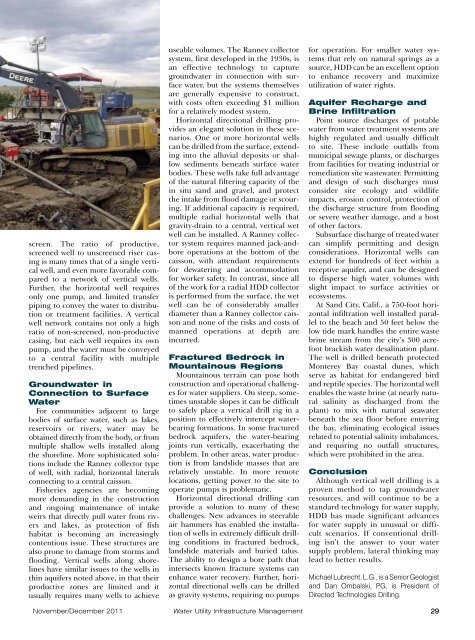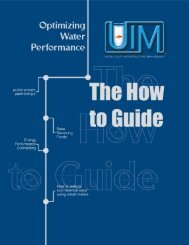Download - Water Utility Infrastructure Management
Download - Water Utility Infrastructure Management
Download - Water Utility Infrastructure Management
You also want an ePaper? Increase the reach of your titles
YUMPU automatically turns print PDFs into web optimized ePapers that Google loves.
screen. The ratio of productive,<br />
screened well to unscreened riser casing<br />
is many times that of a single vertical<br />
well, and even more favorable compared<br />
to a network of vertical wells.<br />
Further, the horizontal well requires<br />
only one pump, and limited transfer<br />
piping to convey the water to distribution<br />
or treatment facilities. A vertical<br />
well network contains not only a high<br />
ratio of non-screened, non-productive<br />
casing, but each well requires its own<br />
pump, and the water must be conveyed<br />
to a central facility with multiple<br />
trenched pipelines.<br />
Groundwater in<br />
Connection to Surface<br />
<strong>Water</strong><br />
For communities adjacent to large<br />
bodies of surface water, such as lakes,<br />
reservoirs or rivers, water may be<br />
obtained directly from the body, or from<br />
multiple shallow wells installed along<br />
the shoreline. More sophisticated solutions<br />
include the Ranney collector type<br />
of well, with radial, horizontal laterals<br />
connecting to a central caisson.<br />
Fisheries agencies are becoming<br />
more demanding in the construction<br />
and ongoing maintenance of intake<br />
weirs that directly pull water from rivers<br />
and lakes, as protection of fish<br />
habitat is becoming an increasingly<br />
contentious issue. These structures are<br />
also prone to damage from storms and<br />
flooding. Vertical wells along shorelines<br />
have similar issues to the wells in<br />
thin aquifers noted above, in that their<br />
productive zones are limited and it<br />
usually requires many wells to achieve<br />
useable volumes. The Ranney collector<br />
system, first developed in the 1930s, is<br />
an effective technology to capture<br />
groundwater in connection with surface<br />
water, but the systems themselves<br />
are generally expensive to construct,<br />
with costs often exceeding $1 million<br />
for a relatively modest system.<br />
Horizontal directional drilling provides<br />
an elegant solution in these scenarios.<br />
One or more horizontal wells<br />
can be drilled from the surface, extending<br />
into the alluvial deposits or shallow<br />
sediments beneath surface water<br />
bodies. These wells take full advantage<br />
of the natural filtering capacity of the<br />
in situ sand and gravel, and protect<br />
the intake from flood damage or scouring.<br />
If additional capacity is required,<br />
multiple radial horizontal wells that<br />
gravity-drain to a central, vertical wet<br />
well can be installed. A Ranney collector<br />
system requires manned jack-andbore<br />
operations at the bottom of the<br />
caisson, with attendant requirements<br />
for dewatering and accommodation<br />
for worker safety. In contrast, since all<br />
of the work for a radial HDD collector<br />
is performed from the surface, the wet<br />
well can be of considerably smaller<br />
diameter than a Ranney collector caisson<br />
and none of the risks and costs of<br />
manned operations at depth are<br />
incurred.<br />
Fractured Bedrock in<br />
Mountainous Regions<br />
Mountainous terrain can pose both<br />
construction and operational challenges<br />
for water suppliers. On steep, sometimes<br />
unstable slopes it can be difficult<br />
to safely place a vertical drill rig in a<br />
position to effectively intercept waterbearing<br />
formations. In some fractured<br />
bedrock aquifers, the water-bearing<br />
joints run vertically, exacerbating the<br />
problem. In other areas, water production<br />
is from landslide masses that are<br />
relatively unstable. In more remote<br />
locations, getting power to the site to<br />
operate pumps is problematic.<br />
Horizontal directional drilling can<br />
provide a solution to many of these<br />
challenges. New advances in steerable<br />
air hammers has enabled the installation<br />
of wells in extremely difficult drilling<br />
conditions in fractured bedrock,<br />
landslide materials and buried talus.<br />
The ability to design a bore path that<br />
intersects known fracture systems can<br />
enhance water recovery. Further, horizontal<br />
directional wells can be drilled<br />
as gravity systems, requiring no pumps<br />
for operation. For smaller water systems<br />
that rely on natural springs as a<br />
source, HDD can be an excellent option<br />
to enhance recovery and maximize<br />
utilization of water rights.<br />
Aquifer Recharge and<br />
Brine Infiltration<br />
Point source discharges of potable<br />
water from water treatment systems are<br />
highly regulated and usually difficult<br />
to site. These include outfalls from<br />
municipal sewage plants, or discharges<br />
from facilities for treating industrial or<br />
remediation site wastewater. Permitting<br />
and design of such discharges must<br />
consider site ecology and wildlife<br />
impacts, erosion control, protection of<br />
the discharge structure from flooding<br />
or severe weather damage, and a host<br />
of other factors.<br />
Subsurface discharge of treated water<br />
can simplify permitting and design<br />
considerations. Horizontal wells can<br />
extend for hundreds of feet within a<br />
receptive aquifer, and can be designed<br />
to disperse high water volumes with<br />
slight impact to surface activities or<br />
ecosystems.<br />
At Sand City, Calif., a 750-foot horizontal<br />
infiltration well installed parallel<br />
to the beach and 50 feet below the<br />
low tide mark handles the entire waste<br />
brine stream from the city’s 300 acrefoot<br />
brackish water desalination plant.<br />
The well is drilled beneath protected<br />
Monterey Bay coastal dunes, which<br />
serve as habitat for endangered bird<br />
and reptile species. The horizontal well<br />
enables the waste brine (at nearly natural<br />
salinity as discharged from the<br />
plant) to mix with natural seawater<br />
beneath the sea floor before entering<br />
the bay, eliminating ecological issues<br />
related to potential salinity imbalances,<br />
and requiring no outfall structures,<br />
which were prohibited in the area.<br />
Conclusion<br />
Although vertical well drilling is a<br />
proven method to tap groundwater<br />
resources, and will continue to be a<br />
standard technology for water supply,<br />
HDD has made significant advances<br />
for water supply in unusual or difficult<br />
scenarios. If conventional drilling<br />
isn’t the answer to your water<br />
supply problem, lateral thinking may<br />
lead to better results.<br />
Michael Lubrecht, L.G., is a Senior Geologist<br />
and Dan Ombalski, PG, is President of<br />
Directed Technologies Drilling.<br />
November/December 2011 <strong>Water</strong> <strong>Utility</strong> <strong>Infrastructure</strong> <strong>Management</strong> 29








